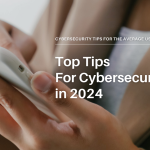In an age where digital threats are omnipresent, arming oneself with knowledge and implementing proactive measures is the first line of defense against cyber attacks. By prioritizing cybersecurity, individuals can safeguard their digital identities, protect sensitive information, and navigate the digital world with confidence and peace of mind.
In the connected digital world of today, cybersecurity is more important than ever. The regular internet user faces numerous dangers in protecting their sensitive and personal data due to the growth of online activities and the sophistication of cyber attacks. With the goal of assisting people in navigating the constantly changing digital risks of 2024, this blog attempts to present critical cybersecurity practices.
Protecting against various dangers such as malware, phishing attacks, and data breaches requires the use of cybersecurity. Internet users must arm themselves with the information and resources need to stay secure online in 2024 since these dangers have only gotten more frequent and sophisticated.
Essential Cybersecurity Practices
1. Strong Passwords & Password Management:
Creating strong, one-of-a-kind passwords for each online account is one of the cornerstones of cybersecurity. Passwords ought to be difficult, combining a variety of letters, numbers, and special characters, and they shouldn't contain any information that is simple to figure out. Furthermore, in order to keep hackers from accessing several accounts in the case that one password is hacked, it is imperative to avoid using the same password for many accounts. Password managers are useful resources that enable users to create and safely store complicated passwords, doing away with the need to remember several login credentials.
2. Multi-Factor Authentication (MFA):
By forcing users to submit various forms of verification before gaining access to an account, multi-factor authentication (MFA) offers an extra layer of security. Authenticator apps, fingerprint scanners, and one-time passcodes sent by email or text message are examples of common MFA techniques. Even in the event that user credentials are compromised, MFA can drastically lower the danger of unwanted access.
3. Software Updates:
Keeping software updated is essential for patching security vulnerabilities and protecting against known threats. Automatic updates ensure that users receive the latest security patches and bug fixes without having to manually install them. Enabling automatic updates for operating systems, web browsers, and applications helps maintain a secure digital environment and reduces the risk of exploitation by cybercriminals.
4. Beware of Phishing Attacks:
Cybercriminals continue to employ phishing assaults as one of their most popular and successful strategies to deceive people into installing malware or giving personal information. Phishing emails can have links to harmful websites or attachments and frequently imitate official correspondence from reliable sources, such banks or government organizations. Users should be on the lookout for warning signs of phishing attempts, such as misspelled names, strange sender addresses, and sudden requests for sensitive information. Phishing scams can be avoided by first making sure emails and messages are real before acting on them.
5. Securing Your Wi-Fi:
Public Wi-Fi networks pose significant security risks, as they are often unencrypted and vulnerable to interception by cybercriminals. Using a Virtual Private Network (VPN) encrypts internet traffic and masks users' IP addresses, providing a secure connection even on untrusted networks. Additionally, securing home Wi-Fi networks by changing default passwords and enabling encryption protocols such as WPA2 helps prevent unauthorized access by intruders.
Advanced Cybersecurity Tips
1. Data Backups:
Regularly backing up data is essential for protecting against data loss due to hardware failure, malware infections, or ransomware attacks. Cloud storage services and external hard drives offer convenient backup solutions that ensure critical information remains accessible in the event of an emergency.
2. Antivirus & Anti-Malware Software:
Antivirus and anti-malware software play a vital role in detecting and removing malicious software from devices. It's essential to use reputable security software from trusted vendors and keep it updated regularly to defend against the latest threats.
3. Social Media Privacy Settings:
Managing privacy settings on social media platforms helps control the amount of personal information visible to others and reduces the risk of identity theft or social engineering attacks. Reviewing privacy settings regularly and limiting the audience for posts and personal information enhances online privacy and security.
4. Being Wary of Online Downloads:
Downloading software or files from untrusted sources can expose users to malware infections and other security risks. It's essential to only download software from reputable sources and verify the legitimacy of downloads before installing them to avoid compromising device security.
implementing essential cybersecurity practices is crucial for protecting against a wide range of online threats in 2024 and beyond. By following the tips outlined in this blog, individuals can enhance their digital security posture and minimize the risk of falling victim to cyber attacks. Staying vigilant, informed, and proactive in adopting cybersecurity best practices is essential for safeguarding personal and sensitive information in today's interconnected digital world.
Call to Action
Share this blog with friends and family to raise awareness about the importance of cybersecurity and encourage them to adopt best practices for protecting their digital assets. Subscribe to our blog for future cybersecurity tips and updates on emerging threats and trends in the ever-evolving landscape of online security.
In an age where digital threats are omnipresent, arming oneself with knowledge and implementing proactive measures is the first line of defense against cyber attacks. By prioritizing cybersecurity, individuals can safeguard their digital identities, protect sensitive information, and navigate the digital world with confidence and peace of mind.








